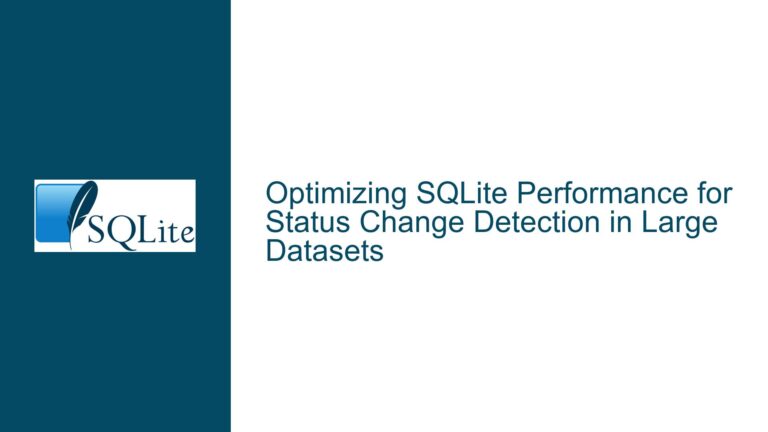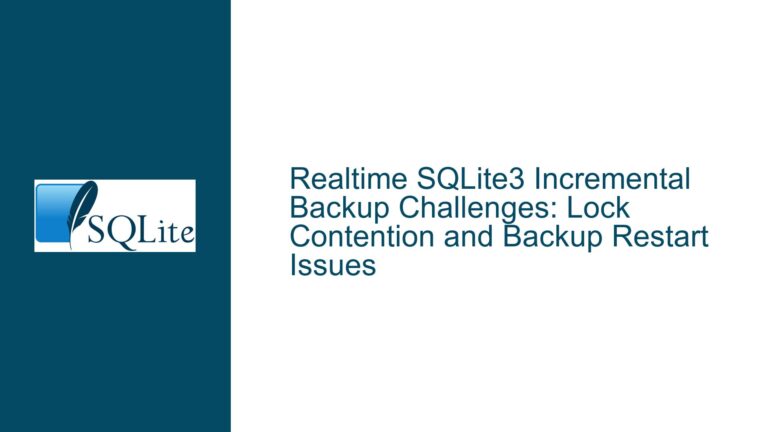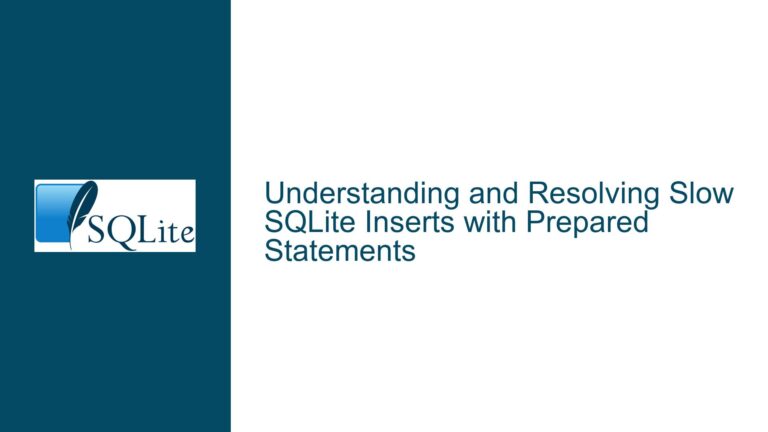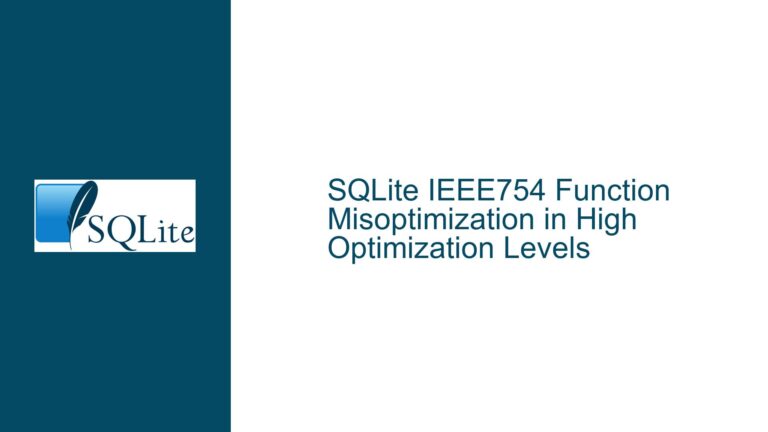Switching SQLite Locking Modes for Backup Without Blocking Writes
Understanding Locking Mode Transitions and Backup Coordination
The core challenge involves transitioning a SQLite database connection from EXCLUSIVE locking mode to NORMAL locking mode temporarily to perform a backup while minimizing disruption to ongoing write operations. The goal is to maintain high performance during normal operation (via EXCLUSIVE mode) while allowing a consistent backup to proceed. However, improper handling of locking modes, transactions, or backup strategies can lead to blocked writes, incomplete backups, or unexpected lock retention. This issue requires a deep understanding of SQLite’s concurrency model, the interaction between locking modes and backup APIs, and the role of journal modes (ROLLBACK vs. WAL) in enabling concurrent access.
Key Factors Affecting Locking Mode Behavior and Backup Integrity
Lock Retention Rules in EXCLUSIVE Mode
When a connection operates in EXCLUSIVE locking mode, it retains a shared lock after the first read and an exclusive lock after the first write. These locks persist until the connection closes or the locking mode is explicitly reset to NORMAL and a subsequent database access occurs. A common oversight is assuming that PRAGMA locking_mode = NORMAL alone releases locks immediately. In reality, locks are only relinquished during the next read or write operation after the mode change. For example, if a backup process starts before the production connection performs a post-mode-change operation, the locks may still be held, causing the backup to wait indefinitely or fail.
Transactional Isolation During Backup Operations
The sqlite3_backup_step(-1) function attempts to copy the entire database in a single transaction, holding a read lock on the source database for the duration. This blocks all write operations from other connections until the backup completes. While this ensures a consistent backup, it introduces latency for write-heavy applications. If the backup is split into smaller steps (e.g., sqlite3_backup_step(100) to copy 100 pages at a time), the read lock is released between steps, allowing writes to proceed intermittently. However, any write to the source database during the backup invalidates the backup’s snapshot, forcing it to restart. This creates a trade-off between backup reliability and write availability.
Threading and Address Space Coordination
SQLite’s backup API has optimizations when the source and destination databases reside in the same process. Specifically, if a backup is active and another thread in the same process modifies the source database, the backup process tracks these changes incrementally. This allows subsequent backup steps to copy only modified pages, avoiding full restarts. In contrast, cross-process backups lack this optimization, requiring full restarts after any source database modification. Thus, implementing the backup within the same process (via multithreading) can reduce contention and improve efficiency, provided thread safety mechanisms like proper mutex usage are enforced.
Strategies for Safe Locking Mode Transitions and Efficient Backups
Step 1: Release EXCLUSIVE Locks Gracefully
Before initiating a backup, the production process must transition from EXCLUSIVE to NORMAL locking mode and trigger a database operation to release locks. The sequence should be:
- Execute
PRAGMA locking_mode = NORMAL. - Perform a no-op read query (e.g.,
SELECT 1 FROM sqlite_master LIMIT 1) to force lock release.
This ensures the backup process can acquire the necessary shared lock. After the backup, the production process should revert to EXCLUSIVE mode:
- Execute
PRAGMA locking_mode = EXCLUSIVE. - Perform a write operation (e.g.,
BEGIN; COMMIT;) to reacquire the exclusive lock.
Step 2: Implement Incremental Backup with Page Limits
To avoid starving write operations, use sqlite3_backup_step(N) with a finite page count. For example:
sqlite3_backup *pBackup = sqlite3_backup_init(pDestDb, "main", pSourceDb, "main");
if (pBackup) {
do {
rc = sqlite3_backup_step(pBackup, 100); // Copy 100 pages per step
sqlite3_sleep(250); // Allow writes to proceed between steps
} while (rc == SQLITE_OK || rc == SQLITE_BUSY || rc == SQLITE_LOCKED);
sqlite3_backup_finish(pBackup);
}
This approach reduces the time the read lock is held, allowing write operations to interleave. However, monitor sqlite3_backup_remaining() to detect if the backup needs to restart due to source database changes.
Step 3: Leverage Same-Process Backups for Incremental Updates
When the backup runs as a thread within the production process, use SQLite’s internal page tracking to avoid full restarts. After the initial backup step, subsequent steps copy only pages modified since the last step. This requires:
- Compiling SQLite with
SQLITE_ENABLE_SNAPSHOTto enable snapshot isolation. - Using
sqlite3_snapshot_get()andsqlite3_snapshot_open()to create consistent read states.
Example workflow:
- Production thread sets locking mode to NORMAL and releases locks.
- Backup thread initializes a snapshot and begins incremental backup steps.
- Production thread resumes writes, with the backup thread copying only delta changes.
Step 4: Evaluate Journal Mode Trade-Offs
In WAL (Write-Ahead Logging) mode, readers and writers can coexist without blocking, as writes append to a separate WAL file. This allows backups to proceed without switching locking modes. Use VACUUM INTO to create a backup while maintaining EXCLUSIVE locks:
VACUUM INTO '/path/to/backup.db';
This command creates a transactionally consistent copy of the database but requires temporary disk space for the full database size. For live backups, combine WAL mode with periodic sqlite3_backup_step() calls, leveraging the WAL’s snapshot capabilities.
Step 5: Validate Backup Consistency and Performance
After implementing any strategy, verify backup integrity using:
PRAGMA integrity_check;on the backup database.- Checksum comparisons between source and backup files.
- Load testing with tools like
sqlite3_analyzeror custom scripts to simulate concurrent writes during backups.
Monitor performance metrics such as backup duration, write latency spikes, and I/O throughput to fine-tune page limits or sleep intervals.
By addressing locking mode transitions, transactional isolation, and journal mode synergies, developers can achieve non-blocking backups in high-performance SQLite deployments. The choice between same-process incremental backups, WAL mode snapshots, or hybrid approaches depends on the application’s write patterns and reliability requirements.






